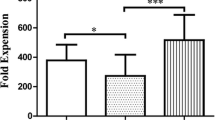Summary
T cell clones derived from a chronic myelogenous leukaemia (CML) patient during interferon α (IFNα, Wellferon) biotherapy preferentially lysed autologous rather than allogeneic CML target cells in an apparently MHC-unrestricted fashion, but also lysed bone marrow cells from certain normal donors regardless of whether or not they shared HLA antigens with the patient. Although T cell clones inhibited both CML and normal bone marrow in the colony-forming assay, they blocked proliferation of CML cells more efficiently than bone marrow cells. This inhibitory effect was mediated at least in part by the tumour necrosis factor α (TNFα) and IFNγ secreted by the clones. Antisera to these cytokines partially prevented inhibition. Involvement of additional factors is also suggested in blocking CML cell proliferation because this was not 100% inhibited even by a combination of TNFα and IFNγ. In addition, most clones failed strongly to block the proliferation of normal bone marrow cells, which were susceptible to inhibition by these cytokines.
Similar content being viewed by others
References
Ashman LK, O'Keefe DE, Juttner CA, Toogood IRG, Rice MS (1986) Autologous responses to human leukaemic cells in mixed leucocyte culture. Cancer Immunol Immunother 22: 95
Barnd DL, Lan MS, Metzgar RS, Finn OJ (1989) Specific, major histocompatibility complex-unrestricted recognition of tumor-associated mucins by human cytotoxic T cells. Proc Natl Acad Sci USA 86: 7159
Beran M, O'Brien S, Andersson B, McCredie KB, Gutterman JU (1989) Tumor necrosis factor and human hematopoiesis: II. Inhibition and mode of action on normal and chronic myelogenous leukemia-derived granulocyte-macrophage progenitor cells. Hematol Pathol 2: 65
Csako G, Binder RA, Kales AN, Neefe JR (1980) Cloning of human lymphocytes reactive with autologous leukemia cells. Cancer Res 40: 3218
Duncombe AS, Heslop HE, Turner M, et al. (1989) Tumor necrosis factor mediates autocrine growth inhibition in a chronic leukemia. J Immunol 143: 3828
Hansson Y, Vargas-Cortes M, Paulie S, Perlmann P (1988) MHC nonrestricted cytotoxic T cell clones with selective specificity from patients with transitional cell carcinoma (TCC) of the urinary bladder. Cancer Immunol Immunother 27: 205
Happ MP, Kubo RT, Palmer E, Born WK, O'Brien RL (1989) Limited receptor repertoire in a mycobacteria-reactive subset of gamma γ T lymphocytes. Nature 343: 696
Heisterkamp N, Jenster G, Ten Hoeve J, Zovich D, Pattengale PK, Groffen J (1990) Acute leukaemia inbcr/abl transgenic mice. Nature 344: 251
Kabelitz D, Bender A, Schondelmaier S, Schoel B, Kaufmann SHE (1990) A large fraction of human peripheral blood gamma/δ+ T cells is activated byMycobacterium tuberculosis but not by its 65-kD heat shock protein. J Exp Med 171: 667
Kourilsky P, Claverie J-M (1989) MHC-antigen interaction: what does the T cell receptor see? Adv Immunol 45: 107
Meager A, Parti S, Leung H, Peil E, Mahon B (1987) Preparation and characterisation of monoclonal antibodies directed against antigenic determinants of recombinant human tumour necrosis factor (rTNF). Hybridoma 6: 305
Okubo M, Sato N, Wada Y, et al. (1989) Identification by monoclonal antibody of the tumor antigen of a human autologous breast cancer cell that is involved in cytotoxicity by a cytotoxic T-cell clone. Cancer Res 49: 3950
Parmiani G (1990) An explanation of the variable clinical response to interleukin 2 and LAK cells. Immunol Today 11: 113
Pawelec G, Schmidt H, Rehbein A, Busch F (1989) Anti-tumour activity in vitro in chronic myelogenous leukaemia revealed after treating peripheral cells with cytosine arabinoside. Cancer Immunol Immunother 29: 242
Pawelec G, Schneider E, Ehninger G, Rehbein A, Schmidt H (1989) Partial correction of defective generation of lymphokine-activated killer cells in patients with chronic myelogenous leukaemia after in vivo treatment with interferon-α (Wellferon). Cancer Immunol Immunother 29: 63
Pawelec G, Schwuléra U, Lenz H, et al. (1990) Lymphokine release, suppressor cell generation, cell surface markers, and cytotoxic activity in cancer patients receiving natural interleukin-2. Mol Biother 2: 44
Rosenberg SA, Lotze MT, Yang JC, et al. (1989) Experience with the use of high-dose interleukin-2 in the treatment of 652 cancer patients. Ann Surg 210: 474
Ruscetti F, Sing G, Burke P, et al. (1989) Role of biologic response modifiers in the growth and differentiation of myeloid leukemic cells. Curr Top Microbiol Immunol 149: 165
Schreiber H (1989) Tumor immunology. In: Paul WE (ed) Fundamental immunology, 2nd edn. Raven, New York, p 923
Somasundaram R, Advani SH, Gangal SG (1988) Propagation of cytotoxic effectors from chronic myeloid leukemia patients and cloning of cytotoxic T cells. Cancer Immunol Immunother 27: 183
Sosman JA, Oettel KR, Smith SD, Hand JA, Fisch P, Sondel PM (1990) Specific recognition of human leukemic cells by allogeneic T cells. II. Evidence for HLA-D restricted determinants on leukemic cells that are cross-reactive with determinants present on unrelated nonleukemic cells. Blood 75: 2005
Van Denderen J, Hermans A, Meeuwsen T, et al. (1989) Antibody recognition of the tumor-specificbcr-abl joining region in chronic myeloid leukemia. J Exp Med 169: 87
Vánky F, Pétterfy A, Böök K, Willems J, Klein E, Klein G (1983) Correlation between lymphocyte-mediated auto-tumor reactivities and the clinical course: II. Evaluation of 69 patients with lung carcinoma. Cancer Immunol Immunother 16: 17
Wölfel T, Klehmann E, Müller C, Schütt K-H, Zum Büschenfelde K-HM, Knutz A (1989) Lysis of human melanoma cells by autologous cytolytic T cell clones. Identification of human histocompatibility leukocyte antigen A2 as a restriction element for three different antigens. J Exp Med 170: 797
Yssel H, De Vries JE, Koken M, Van Blitterswijk W, Spits H (1984) A serum-free medium for the generation and propagation of functional human cytotoxic and helper T cell clones. J Immunol Methods 72: 219
Author information
Authors and Affiliations
Additional information
This work was supported in part by the Deutsche Forschungsgemeinschaft (SFB 120)
Rights and permissions
About this article
Cite this article
Pawelec, G., Reutter, M., Owsianowsky, M. et al. Cytotoxic and noncytotoxic mechanisms involved in the in vitro anti-leukaemia effects of T cell clones established from a chronic myelogenous leukaemia patient during treatment in vivo with interferon α. Cancer Immunol Immunother 33, 54–60 (1991). https://doi.org/10.1007/BF01742529
Received:
Accepted:
Issue Date:
DOI: https://doi.org/10.1007/BF01742529




